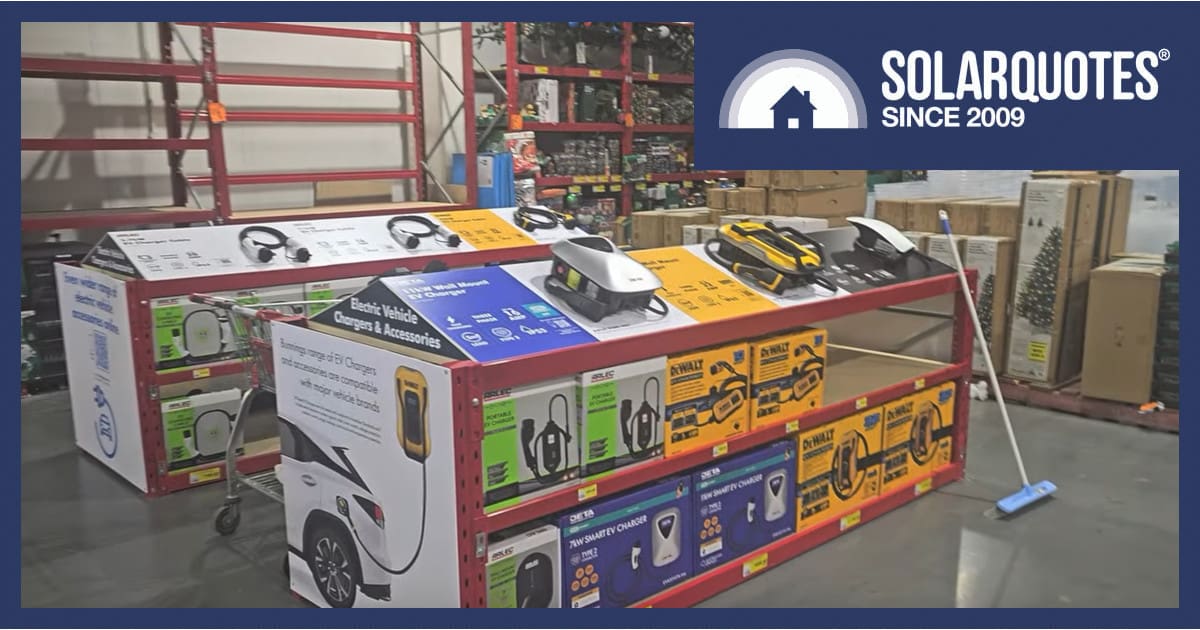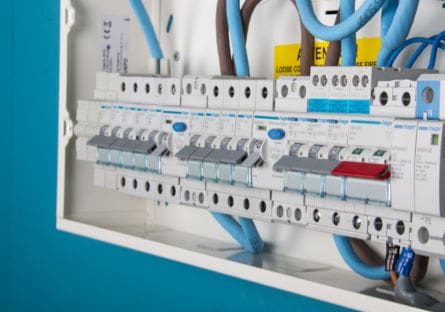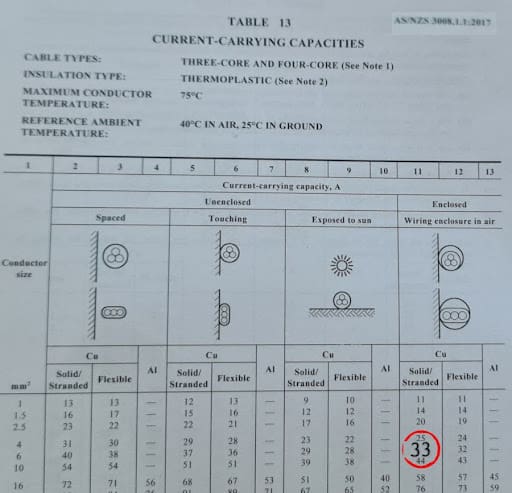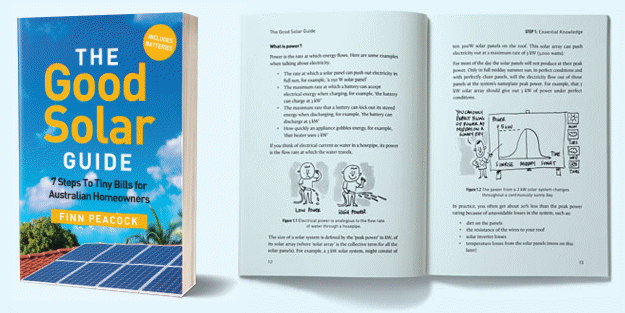
Bunnings EV charger displays, photo posted November 19th 2024
It seems you can buy just about anything at Bunnings these days, with EV charging systems the latest addition to the ever-growing hardware store.
The original version of this article has been updated with comment and corrections from Bunnings.
The big green shed has caused a stir in EV enthusiast circles by launching yet another contentious line of merchandise, complete with warning labels on their displays telling customers they will need qualified installation — so SolarQuotes decided to investigate.
After crawling through Binno’s websites, pursuing web chats, and even enquiring in-store, we found that, unsurprisingly, the people selling paint and pot plants don’t know what the pointy end of an EV charger looks like.
What Could Possibly Go Wrong?
In my opinion the installation service Bunnings offers to sublet isn’t of a high standard, and this is not a project you should risk undertaking yourself: we’ve covered the perils of unqualified electrical work a few times in the past, from electric shocks that can knock you off your ladder to the dangers of pests chewing through exposed wiring.
This isn’t the first time the company that describes itself as “Australia’s DIY, Garden & Hardware store” has moved into products that require a professional. You might technically need a license to install a new tap from Bunnings, but the risks posed by a water leak are pretty low (I could make a joke here about a plumber’s licence to make sh!t flow downhill).
I would never recommend people do their own gas plumbing with the fittings available at Bunnings. If that goes pear-shaped, it can level your house and kill all the occupants in an instant. That’s a good reason to get off gas, in any case.
A Bunnings representative advised SolarQuotes that “Bunnings is, first and foremost, a home improvement store. This means our customer base is not only the DIY customer, but also includes the trade customer” and that the company “advises customers, both at point of sale and online, that all hardwired electric vehicle wall chargers must be installed by a qualified electrician.”
EV Chargers Require Permission
After checking out a point-of-sale display with DETA, DeWalt and Tesla EVSE equipment, we found that only the Tesla QR code worked when scanned in-store, while the others had broken links. It seems the Tesla and DeWalt units were the only Open Charge Point Protocol (OCPP) compliant options, which are legally required to install in South Australia, the state where the display was located.
There are 17 different network companies in Australia and they all have differing requirements for EV charging equipment to be connected, through your retail meter, to their poles and wires. Not all of them mandate OCPP connectivity right now, but they will soon enough.
Permission Comes Via Your Electrician
The green shed retailers can’t actually organise your installation, as they don’t have the licence or the login to use the appropriate Distributed Network Service Provider (DNSP) portal. Rather, they offer to get a subcontracted electrician to do the preparation, installation and compliance (“starting from” a rock-bottom price of course).
Bunnings has clarified that warranty works on a defective unit will be paid for, as they should under consumer law.
However, the DETA wall connector at Bunnings’ flagship store at Mile End has now disappeared, presumably because it is non-compliant and can’t be installed in SA.
Bunnings advised SolarQuotes that: “Due to the state-specific regulations relating to the Demand Response requirements, the Arlec and DETA EV chargers are not offered for sale in South Australia.”
The Fine Print of The Bunnings Offer
The installation Bunnings specified starts from $699 (although a basic install quote requested by SolarQuotes reached $843 including GST and an “EV Charger Attendance Fee”). The install includes 10 metres of 6mm² Four Core and Earth (4c&e) sheathed cable (ie suitable for 3 phase).
In the original version of this piece, I made a common assumption: I mistakenly said Bunnings’ installation involved a 32amp circuit breaker. Bunnings actually didn’t specify circuit protection in the installation guide but has since advised us: “a 40amp circuit breaker and 6mm² cable … forms the basis of the offer however, dependant on the site requirements, the specifications for the circuit breaker and cabling may increase to ensure that all installations are AS/NZS3000 compliant.”
In my view this 6mm² cable simply isn’t enough – in fact nominating a 40a supply on the same wiring I assumed was 32a just makes matters worse.
The cable Bunnings offer is rated for an absolute maximum of 40 amps. However if the surrounding conditions aren’t perfect it simply doesn’t pass muster.
Electricians Are Argumentative Asses
You’ve heard the saying, assumptions make an ass of u & me. Many qualified people will die on a hill defending their mistakes, but even though it’s an incredibly common rule of thumb, 6mm² cable doesn’t automatically mean a 32 amp circuit.
It’s great that Bunnings have clarified that their offer complies with AS3000 clause 1.7.1(c)1 but I still worry that by offering 6mm² cable by default, they are making it much more likely that 6mm² cable will be the default used.
I’d suggest Bunnings drop the mention of cable gauge (or breaker size) from the offer altogether.
Cable Sizes Need To Match The Circuit Breaker
AS3000 specifies the minimum standard and defers to manufacturer instructions as part of the rules.
Schneider Electric (the company that bought Clipsal) has specific considerations for circuit rating and protection in switchboards:
- A 40A circuit is required for each charging outlet.
- This is necessary because the continuous output current from the charging station can be as high as 30A.

Increasing EV charging cables from 6mm² to 16mm² will mean the job costs a little more, but doing it right will be a lot cheaper than doing it twice.
Electrical switchgear manufacturer Hager recommends a 40A protective device for a typical 7 kW domestic charger, based on testing conducted in their accredited laboratory.
In fact, Hager goes further. If your switchboard is full, it’s liable to be heat-soaked after hours of EV charging, so they recommend you double the circuit breaker rating to counter the thermal derating on a crowded DIN rail.
This means the cable sizes must be increased to match the circuit breaker – with a potential 30 amp load, doubling the circuit capacity means a 63 amp breaker and minimum 16mm² wiring.
The silver lining for this oversized cable is greater efficiency. More of the energy you pay for will end up in the battery instead of being burnt off as waste heat.
Heat Is The Killer
EV charging is unlike any other common domestic load. It’s not only the largest but also the longest.
Where a stove may have high demand to boil pasta for ten minutes, the simmerstat (temperature control) means the consumption is moderate while you make jam. Stoves aren’t designed to run all the hotplates, all the time, all at full heat, so there’s a carve-out in AS3000 rules to reflect this diversity.
The same is true for air conditioning. Once switched on, it may work hard for an hour, pulling the temperature down in summer, but then it will throttle back, either by cycling or dynamic speed control.
EV chargers, in contrast, come on at a full 7kW, and they can run for 6 or 16 hours flat out.
This means the whole system must be able to cope with full-rated capacity, when everything is soaked with internal electrical heat and external environmental heat.
A Basic Failure
You’ll commonly find cables are thrown into a low portion of the roof, simply laying across the top of bulk insulation, meaning they are defined as “partially surrounded with thermal insulation.”
- So, at this first hurdle, the bargain install falls short, with the 6mm² cable only rated for 30 amps in this very typical situation.
- It gets hot in your roof space, and even at a fairly modest 50°C, the cable loses another 18% capacity.
- Realistically, a 60ºC figure means 30 amps x 0.6 or a safe rating of 18 amps.
- If the cable is bunched together, touching others, it may suffer a further 0.85 rating.
In other words, this nominal 40 amp cable can only safely carry 15.8 amps once you’ve applied some conservative but not unrealistic conditions.
It’s all about how and where the cable is installed. For example, Current Carrying Capacity (CCC) is more than halved if it’s “completely surrounded by thermal insulation”, which is why you need a competent electrician, not a retail rule of thumb.
The Importance Of Protection
While 6mm² 4c&e cable has a rated Current Carrying Capacity (CCC) of 40 amps under ideal conditions, it must be installed in what the standards call a “spaced” manner.
Spaced means the cable must be free to radiate heat into an environment with an ambient temperature of less than 40°C. Think of it as a freshly baked cake cooling on a wire oven shelf.
The only practical way to make this compliant is to use a perforated steel cable tray, or perhaps a wire mesh product from Bunnings’ own shelves.
It’s good to see Bunning’s standard offer will mechanically protect cable with conduit. However, the inclusion of conduit into a wiring system serves to derate the cable thermally. 6mm² 4c&e cable inside a wiring enclosure, in air, has a CCC of 33 amps,
so it’s not suitable for a 40 amp circuit.
Of course there’s a few apps to check that figure, but for anyone who’s paid the hundreds of dollars needed to access our electrical standards, they can look up AS3008.1.1.2017, page 62, table 13, column 11, line 5:
Some Electricians Recommend Bunnings EV Chargers
Tesla, amongst others, offers mail-order EV charging equipment, so customer-supplied hardware isn’t highly unusual. While your local sparky might lose some margin, it saves them on wholesaler handling and warranty obligations.
However if you want an EV charger with best-practice technical integration, you’d best look elsewhere for now.
The silver lining of Bunnings getting involved is that it is another sign that EV charging is going mainstream. The install of EV chargers just needs to be done to standard, not price, and setting customer expectations too low will only leave a bad taste in everyone’s mouth.
For a broader overview on Bunnings’ EV chargers, take a look at our dedicated page on what they are offering. Dive into this EV charging guide if you’d like to do your own research.
Footnotes
- electrical equipment shall be installed in accordance with the requirements of this Standard and the additional requirements as specified in the manufacturer’s instructions. ↩


 RSS - Posts
RSS - Posts



I’ve been told many times, including from electricians, Never buy anything electrical from Bunnigs.
I’ve been reading you since I did my due diligence when I got solar panels. I just wanted to say thank you, because articles like this is what we need to know. I’ve given my wife notice that we’re getting an EV when I can drive to Sydney (from nsw northern rivers) on a charge in a $30k car and we’re going off grid when batteries become half current prices. She of course took no notice… LOL. So, thanks and cheers
700kms range from a $30K EV – you’re actually probably not that far off being able to do that I reckon – give it a couple of years
Don’t they also require an RCD for protection on the AC side?
What source are you using for your current ratings and other numbers for 6mm² cable? The numbers look off and it makes me doubt the whole article.
Hi Danny,
The numbers come straight from AS3008
Going on the reactions here I’m going to have to write an entire article on cable sizing once I’m back from leave…
Reminds me of when i ended up looking for a smart fluro lightbulb because i couldn’t find a good smart light switch to have one swapped to.
Looked at Bunnings one then checked the reviews.
So say the least that left me thinking how they were legal to sell in Australia.
They apparently melted and potentially ignited disturbingly commonly.
It sounded like they cheaped out on the electrical components of the “smart” part with parts not properly rated for mains power.
Your best bet with Level 2 charging is to install, whenever you possibly can, 3-phase devices.
There are many befirts to upgrading your current home or specifying 3 -phase for new builds, besides managing power hungry devices (like EV chargers and large compressors etc) ranging from supply stability to being able to support larger solar arrays.
So Tom, you are the fist to mention “Level 2”. No many electricians or BEV enthusiasts in Australia are familiar with Level 1, 2, & 3. Yet it is common in North America, where the poor consumer can’t have 3 phase. I have installed my own 240V 40A “charger” (not really a charger, it is an IOT connection point) in Toronto (L5H2E4) 7 years ago – GM Bolt. As I see most new home installs (5074) have 3 phase main breaker, and should be legistrated for BEV rough in, do you think we will start to see more 3 phase devices. I know heat pump HVAC systems can specify 3 phase (should be less $ but not), how about refrigerators, ovens, dryers, induction cooktops etc?
Much appreciated the wide and knowledgeable facts on topic
What an article, never ever does the Circuit breaker size have anything to do with the appliance, it has zero , zilch , you can happily run your toaster off a 63a circuit breaker with a 10a power point as long as the cable can handle it , circuit breakers protect cables , not devices , so your article is extremely inaccurate among other things
Your comment prompted us to get a second opinion from installer Ashley Turner of Adelaide SolarSafe. Ashley said the following: “The circuit breaker does have something to do with the device as the max demand of the device will determine the rating your circuit breaker needs to be. And the device itself will have its own internal wiring with its own ratings. A toaster has 2.5mm2 or 1.5mm2 cable attached to it so maybe if practically the toaster won’t draw more than the cable can handle its a bit over the top to even suggest it would be safe to run this off a 63A circuit.” We’ve also updated the article with further comment from Ashley.
I am also a licenced electrician with an electrical contractors licence, however I am not a roof possum like Anthony.
This has to be scaremongering at its highest, possibly due to a conflict of interest, can’t explain it otherwise.
Very disappointed reading this article.
P.S Yes this is positive intention.
Russell,
It is my read that “manufacturer’s recommendations” to overspecify cabling and breaker is bum-covering which allows them to sell cheaper breakers with slacker production tolerances, i.e. a tendency to thermally trip a bit prematurely. Instead of supporting rated current indefinitely,they wimp out. It will though reduce I²R losses a smidge, and extend breaker lifetime, undeniably.
My 32A breaker on the EVCS circuit is packed in beside another from a PV inverter which usually supplies at least half of the load, so always adds to the localised thermal loading. Through four seasons now, it has supplied over 1.8 MWh to the EV, most often at 7 to 7.3 kW, for up to 5 hrs per session. It is yet to thermally trip – and that would be the sum of the inconvenience, I figure. (For as long as it lasts.)
I must though grant that cable derating for anything other than a free air run is important. (I’ve had the horrible stink of cooking insulation, when the installer forgot to tighten a capscrew on a DC breaker. That necessitated a breaker replacement shortly after commissioning, and a new lug on the DC cable. Anything similar lurking in a wall is not to be contemplated.)
I would have preferred the more capable circuit, if I’d thought of it at the time – not running so hot is always cool.
Hi Russel,
I’d really appreciate the feedback if you think there’s inaccuracies here.
At this rate I’m going to have to write an entire article on cable sizing once I’m back from leave…
Seems many have forgotten about temperature derating and they just default to rules of thumb instead.
No mention of safety switch requirement nor re-assessment of mains cabling and possibly earth cabling size.
That also brings up the possible switchboard upgrade requirement.
I had the same thought. So many older homes have inadequate entry point to switchboard cable, not rare to see 6mm still and very common 10mm. Getting an upgrade to 16mm costs a pretty packet
Hi Jeff,
We’ve done a few articles on this before but it might be worth stitching them all back together with another visit to the subject of upgrades.
Cheers
https://www.solarquotes.com.au/blog/solar-switchboard-upgrade-guide/
https://www.solarquotes.com.au/blog/get-a-bigger-switchboard/
I had a SolarEdge charger installed by a local solar company that is rated highly on your site. After reading your article I went and checked the circuit breaker, it’s a 32 A breaker. Should I be concerned Anthony?
Anthony is currently on leave but I ran your question past installer Ashley Turner of A.R. Turner Electrical, who said: “6mm2 is fine on a 32A breaker and is VERY widely used in the industry as a combination. The install of a 7kw EV charger on this circuit would of course be up to the installers discretion based on the way the cable is run in each different situation. But run in conduit from the switch board to the EV charger would be perfectly fine.” I’ve included his opinion in the story as well.
I would never buy something as niche as an EV charger (for the present time at least) from Bunnings, just like I would never rely on a pacemaker from Temu. But to suggest that a 7kW charger would need double the rating of a 40A breaker (ie 16mm cable) seems quite extreme. For someone who knows what they need, and of the limitations of the package they are getting it could well work for many people.
I installed the Tesla Wall connector (charger). I used 3 phase 4mm2 cable run over 15m. It was run inside the roof space in the garage and down a conduit inside a masonry wall.
There was no insulation anywhere and the roof space doesn’t get hot because there’s a room above the entire garage hence it’s not a roof space exposed to the sun. Consequently I rated it for 35 degrees when doing the calculations.
The CB was rated at 25A and the charger set to 17A in the settings as it’s connected for 3 phase (which is a difficult setting to change).
The calculations rated the max current at 27A including the derating due to the conduit, hence I used a 25A CB on its own in a new sub board enclosure.
I tested full power running for an hour (16A for each of the 3 phases as that’s the max the car will draw) and no appreciable heat was generated.
It took me a full day to do the work. I’m not an electrician but I am a practising electrical engineer.
I don’t encourage people to do it but it’s not a big deal IF YOU KNOW WHAT YOU ARE DOING.
As for Bunnings selling DIY chargers – pretty much anyone who buys one isn’t going to attempt DIY unless they are like me. With grossly exaggerated stories in the media about EV and EV charging fires, people are very cautious and unless they feel confident, they won’t attempt to do it. To a large extent illegal DIY will be self policed.
Is the Tesla Wall Connector 3 OCPP compatible?
No but apparently it will be soon. How come?
Are you in Australia? If so you need to get your install inspected by a licensed electrical inspector, don’t you?
Also I don’t think you’ve future proofed your install. What happens if you plug in a single phase vehicle that draws 7kW on a single phase? It’s going to draw more than 25Amps. What if you swap cars or sell the home?
Not criticising but just wondering what your thinking was? Did you have other limitations on your board that prevented going to a higher rated circuit?
Yes I am in Australia. I could get inspected but I’ve already discussed it with him and it’s fine for my situation.
My thinking was the installation is just for me ie 3 phase. I own the house and we have no intention of selling or moving so it’s the M3 or nothing.
If the next owner wants to charge a single phase car like a BYD, they can make the required changes quite easily.
Bunnings ec chargers!
As always, jokes about needing a Plumbing licence from someone who obviously does NOT know the risks involved by not using a Licenced plumber to do work, required by a Licenced trade!
“You might technically need a license to install a new tap from Bunnings, but the risks posed by a water leak are pretty low”
You may need to contact some insurance companies about what their biggest claims are? Ever known someone that has had a flooded house?
Also not to mention warranties of tapware.
Also non compliant tapware being installed around Australia, that risks alot more than a “low risk” for not only your health but potentially a whole street, or suburbs health.
You guys prove over and over again your limited knowledge of maintenance.
And now trying to be funny about sh*t running downhill needing a Licenced trade!
Maybe you should go and clean some of that sh*t up from people laying their own pipes with incorrect fall then concreting it over to make it inaccessible.
I’ve followed your good and bad articles over the years. And not really impressed with they way you started this article, trying to put another trade into a lower category than you high and mighty electricans!
Every trade is Licenced for a reason. The main reason I’ve learnt over my 30+ years of Plumbing, Gas, roofing and Drainage. And going on 15 years of Solar Panel Cleaning. Is the keep the general public here in Australia Safe from dangers and unhealthy situations.
I myself think you need to retract what you have written about Plumbing!
And offer up an apology to any other Licenced trade you may think is funny.
Hi Scott,
I’m sorry; however as a licenced electrician, ceiling fixer, roof plumber, building contractor & supervisor I can poke fun at myself.
As you’d be aware there are more than a few traditional rivalries between building trades.
The banter says concreters know they’re at the bottom, carpenters think they’re all the sons of god, electricians all deem themselves GOATs and plumbers operate above and below everyone, but we all acknowledge if there’s no ladder handy you can always stand on a plumbers wallet to get into the ceiling.
The point is that bad plumbing won’t burn your house down and won’t generally electrocute you, unless someone has broken an earth path by installing plastic pipes, which is a blog I’d invite you to write if you’d like.
Perhaps have a read here, the 4th paragraph points out that even GOATs aren’t immune to failures.
Cheers for the feedback
Thank you for a reasonably comprehensive coverage of EV charger topic. I think consumer awareness is important in this area dealing with any supplier. I’ll be sure to check out your recommended reading links. Hoping to find a checklist which could be applied to choosing and installing.
Vested interest on your part renders this article both biased and irrelevant… hyperbole like “Dodgy EV charger installs are just the beginning” and assuming a lesser standard of installation by contracted installers shows your biased view…
This article comes across as more of an attempt to criticize Bunnings while promoting the brands featured on this site. It’s important to maintain a balanced and objective tone to build credibility. Also, let’s not forget that SolarQuotes was acquired by Origin Energy last October, which might influence perspectives.